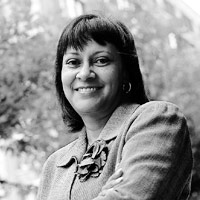| |
 |
| |
B.
Diane Williams '94 |
| |
|
Alumni
Profile: B. Diane Williams '94 (EMP-29)
Path
maker
Helping
those who have 'made bad decisions’ find their way back
into productive society allows B. Diane Williams '94 the satisfaction
of making a difference
By Deborah
Leigh Wood
Eight
years ago, Ameritech made a loan it couldn’t collect
on. But in the long run, society benefited.
Ameritech’s
“loan” was B. Diane Williams, one of its top managers,
who was sent to assist the Safer Foundation, a Chicago nonprofit
that helps ex-offenders obtain jobs and re-enter society.
In 1996, Safer’s president and CEO died, and Williams,
who had been on Safer’s board for 10 years, was appointed
to replace him.
Like the
ex-offenders who come to the Safer Foundation, Williams sometimes
reflects on her past. Unlike her clients, it is with gratitude.
Williams, who earned her MBA from the Kellogg School’s
Executive MBA Program in 1994 (EMP-29), says her corporate
experience has given her the skills to run a successful, fiscally
responsible nonprofit.
As president
of the Safer Foundation, Williams oversees 30 employees who
work in the organization’s no-frills office at 571 W.
Jackson or at one of 14 other sites throughout metropolitan
Chicago and the Quad Cities.
On a recent
morning, the waiting room at Safer is packed with clients
who have appointments with counselors. The room will stay
packed all day as clients come and go.
“In
2000, 4,300 people with criminal records knocked on our doors,”
Williams says. “Last year it increased to 8,300. But
our resources didn’t double. We work with anyone who
can give us funding --- government, foundations, individuals,
legislators.”
As a former
board member, Williams had some sense of who Safer’s
clients were, but, she says, “it wasn’t at all
clear until I worked here how many clients Safer serves or
what they need.”
Perhaps
Williams’ biggest revelation was that “Safer’s
clients look like people you know. The media would lead you
to believe they all look like Willie Horton, but that is simply
not true.”
Growing
up in several Chicago neighborhoods, Williams was surrounded
by two distinct groups: those who would wind up in prison,
like her clients, and those who would rise to top management,
like herself. Williams says she became one of the latter because
she immersed herself in reading.
“Reading
is a huge part of what allowed me to think differently,”
she says. “Through reading, the world was always bigger
than my neighborhood.”
As head
of the Safer Foundation, the world is her neighborhood. She
travels extensively throughout the United States and abroad
as a consultant to groups who are trying to set up similar
agencies.
The organization
has been a model for integrating ex-felons back into society
through job and life training programs. It was established
in 1972 by two former priests who chose its name because they
wanted to make the community a safer place by helping ex-offenders
find meaningful employment. The foundation’s tag line
is “A Road Back for Offenders.”
Williams
frequently flies to Washington, D.C., where she serves on
the advisory board of the National Institute of Corrections
of the Department of Justice. She was appointed to this three-year
position by U.S. Attorney General John Ashcroft.
Williams
says she views her clients “not as bad people, but as
people who made bad decisions.” She says it’s
difficult to separate work and personal life as head of an
organization that requires “leadership with a mind and
a heart.” As a child of the '60s, she says, “I
knew that I would eventually work in the not-for-profit arena.”
Before
she arrived at Safer, Williams says she blamed the corporate
world for the stress that jolted her awake at 3 a.m., worrying
about things she had to do.
“I
still wake up at 3 a.m.,” she says, “but now I
see somebody’s face and ponder how we can help that
person succeed. It makes me work even harder.” |





